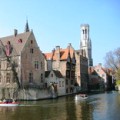
A (very brief) Guide to Bruges
The Historic Town of Brugge hides stunning architectural monuments within its egg-shaped boundary. It is the home of both modern and medieval masterpieces. It was honored in 2012 with the title of European Capital of Culture. It boasts of its grand Royal Theater and of the Concertgebouw, where one can hear contemporary music or watch ballet performances. The city preserves many amazing landmarks within its walls.
Predominant Architecture:
Unspoiled for hundreds of years, the city’s canals, churches and cathedrals date to the Middle Ages, most of the cityscape preserved in its medieval existence as the leading port city of Northwest Europe. Gothic Architecture is best represented here.
Places to see:
Grote Markt of Brugge: The central square of Bruges. It is flanked by several important historical buildings and is the starting point of walking tours around the city.
The Burg: A small square located in the heart of Bruges. It is flanked by many historic buildings and is the administrative center of the city.
Bargebrug: The contemporary Barge Bridge connects Minnewater Park and Barge Square. The bridge is really eye catching – it is bright red and is asymmetrical in form.
The Church of Our Lady: It dates mainly from the 13th, 14th and 15th centuries. Its tower, at 122.3 meters, is the tallest structure in the city and the second tallest brickwork tower in the world Image Courtesy
Provost’s House: One of the jewels of the Flemish capital is the Provost’s House. It is an amazing Baroque-style white structure built in 1666. Originally, it served as the bishop’s residence and continued so until 1794. It is located in Burg Square and is currently occupied by government offices.
Provinciaal Hof: The city of Brugge boasts impressive medieval architecture mixed with some marvelous 19th century buildings. The Provinciaal Hof or Provincial Court is an astonishing Neogothic building. Located in the Grote Markt, it houses the headquarters of the government of West Flanders and the post office.
Poortersloge: or Burgher’s Lodge is a worthy representative of the Gothic architecture of Brugge. It was built at the end of the 14th century and served as a meeting place for the burghers.
Hof Bladelin: is a large mansion in Bruges. It was built in 1451. It is now a convent and home for the elderly with a small museum inside.
Ezelpoort: or Donkey’s Gate, is one of the four remaining medieval city gates of Bruges. Unlike the other gates that were built on the banks of the canal, it is completely surrounded by water.